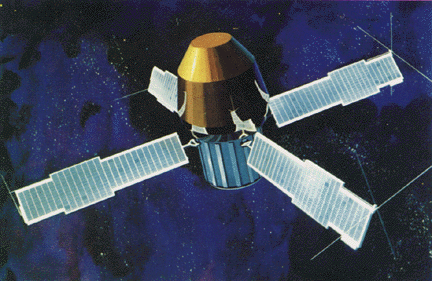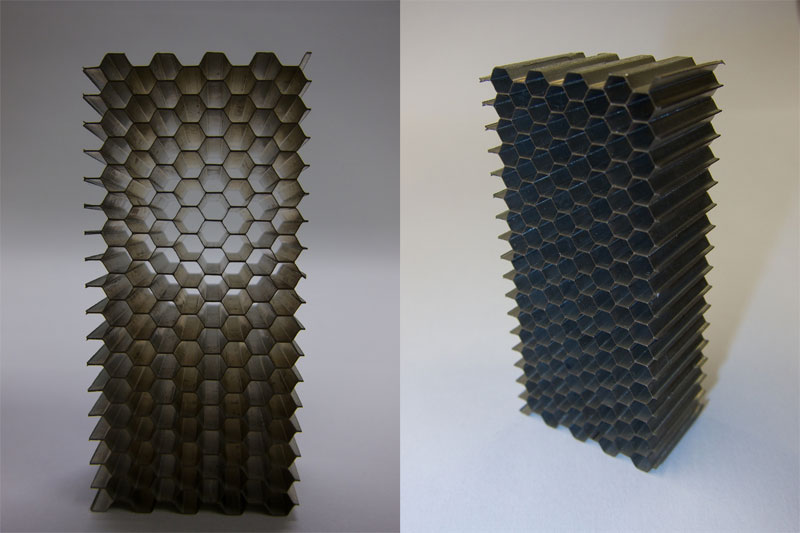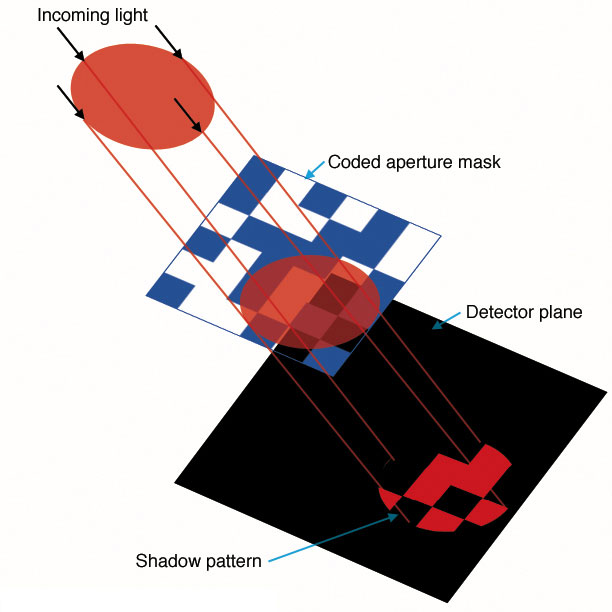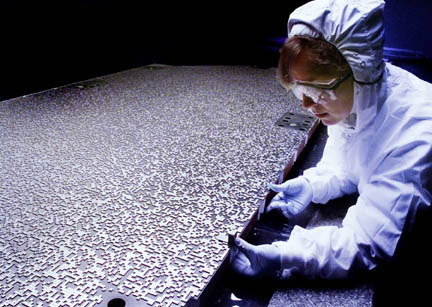Gamma-ray Telescopes Introduction

Artist's impression of the SAS-2 satellite. SAS-2 was the first dedicated orbiting gamma-ray telescope. (Credit: NASA)
Visible light can be focused by using mirrors or lenses to bend the paths of the photons and concentrate them in one place. This creates a sharper, brighter image. Focusing gamma-rays is not easy. When a gamma-ray hits matter, it interacts in such a way as to destroy the gamma-ray or significantly change its energy. That means traditional mirrors and lenses don't work for focusing gamma-rays.
As discussed in the introduction to X-ray Telescopes, X-rays are focused using "grazing incidence" mirrors, so that the incoming photons just skip across the surface of the mirror, like a stone skipping on water.
Gamma-rays, however, are even more energetic than X-rays, so they would have to come in at an even shallower angle, which makes grazing incidence mirrors impractical for gamma-ray astronomy. In fact, gamma-ray telescopes generally don't use focusing optics. Instead, scientists have developed other techniques to ensure that they know where in the sky the gamma rays are coming from.
Gamma-rays can come toward a telescope from all directions, but when making astronomical observations, you want to be sure that you are only studying the gamma-rays from a particular source or region. Three common methods used in gamam-ray astronomy are collimators, anti-coincidence shields, and coded aperture masks. Telescopes generally combine two of these methods.
Collimators

Photo of the collimator used on the proportional counter array on the Rossi X-ray Timing Explorer satellite. (Credit: Craig Markwardt/NASA Goddard Space Flight Center)
Collimators are a workhorse of high energy astronomy, being used on X-ray and gamma-ray telescopes. You've probably used a collimator without realizing it. Imagine going outside on a sunny day and looking toward a flower. As you look, you are also seeing all kinds of other things in the periphery of your vision – maybe the sky, a yard, a house, a tree, or other flowers. Now, if you cup your hands around your eyes and look at that same flower, suddenly you'll seem much less of your surroundings. Your hand is acting as a collimator.
The way a collimator works is to only allow light coming from certain angles to make it to the detector (in the above example, the detector is your eye). The smaller the diameter of the collimator, the less light that is allowed in. For example, imagine that you looked at that flower through a paper towel tube instead. In that case you would see even less of your surroundings. Making a collimator has the same effect.
On a telescope, collimators are not just single tubes, but a honeycomb of tubes. The tubes have to be made of material that will stop an incoming gamma-ray (or X-ray in an X-ray telescope), otherwise it would be as if the collimator wasn't there.
Anti-coincidence Shields
What happens if a gamma-ray could come directly in the side of a telescope to be registered by the detector? The detector wouldn't know the difference between that gamma-ray and ones from the source you're trying to observe. It would simply record the presence of a gamma-ray. Many gamma-ray telescopes have an anti-coincidence shield to protect against those gamma-rays being counted as one from the object of interest. These shields also protect against cosmic rays that can enter the detector which can mimic a gamma-ray in the detector.
An anti-coincidence shield is essentially another detector. Gamma-rays and cosmic rays that pass through it leave a signal, and then are absorbed by the detector, leaving a second signal in the detector. Computer software that analyzes the data will see that there were two signals within a very short amount of time of each other, one in the anti-coincidence shield and one in the detector. That signal in the detector is then rejected, so that scientists only use the "good" signals that come from the right direction.
Coded Aperture Masks


Diagram of how a coded aperture mask works and a photo of an engineer working on the coded aperture mask used for the Burst Alert Telescope on Swift. (Credit: NASA's Imagine the Universe and NASA/Swift)
A coded aperture mask doesn't exactly keep out unwanted photons, but provides a way to determine the direction photons entering the detector came from. It works by casting a gamma-ray a shadow on the detector.
A coded aperture is a mask positioned in front of the gamma-ray detectors. It is made of a material that will stop gamma-rays, but only about half of the mask is covered in that material. The rest of the mask is open, allowing gamma-rays to reach the detector. When a gamma-ray source shines gamma-rays on the detector, about half of them are stopped by the coded aperture mask, and about half get to the detector. By looking at the pattern of gamma-rays on the detector, computer analysis will show where those gamma-rays passed through the aperture.
This is a little like watching the a beam of light from a skylight move during the day - you can tell which direction the sun is in relation to the skylight by where that patch of light lies on the floor. Just like the patch of sunlight from the skylight, those computers can then tell scientists which direction the gamma-ray signal came from by mapping the shadows.
Text updated: September 2018


